2000 BMW 328Ci COUPE turn signal
[x] Cancel search: turn signalPage 12 of 189

Contents
Overview
Controls and features
Cockpit 16
Instrument cluster 18
Indicator and warning lamps 20
Multi-function steering wheel 24
Hazard warning system 25
Warning triangle 25
First-aid kit 25
Refueling 26
Fuel specifications 26
Tire inflation pressure 27
Locks and security systems:
Keys32
Electronic vehicle immobilizer 33
Central locking system 34
Door locks – from outside 34
Using the key 34
Using the remote control 35
Door locks – from inside 38
Luggage compartment lid 39
Luggage compartment 41
Alarm system 42
Electric power windows 44
Sliding/tilt sunroof 45
Adjustments:
Seats47
Seat and mirror memory 50
Steering wheel 51
Mirrors 52
Car Memory, Key Memory 54
Passenger safety systems:
Safety belts55
Child restraint systems 56
Airbags 57
Driving:
Steering/ignition lock 62
Starting the engine 62
Switching off the engine 63
Parking brake 64 Manual transmission
65
Automatic transmission with Steptronic 66
Turn signal/Headlamp flasher 69
Wiper/washer system/Rain sensor 69
Rear window defroster 71
Cruise control 72
Everything under control:
Odometer74
Tachometer 74
Energy control 74
Fuel gauge 75
Temperature gauge 75
Service Interval Display 76
Check Control 77
Clock 77
Onboard computer 77
Technology for safety and
convenience:
Park Distance Control (PDC) 80
Dynamic Stability Control (DSC) 81
Tire Pressure Control (RDC) 82
Page 19 of 189
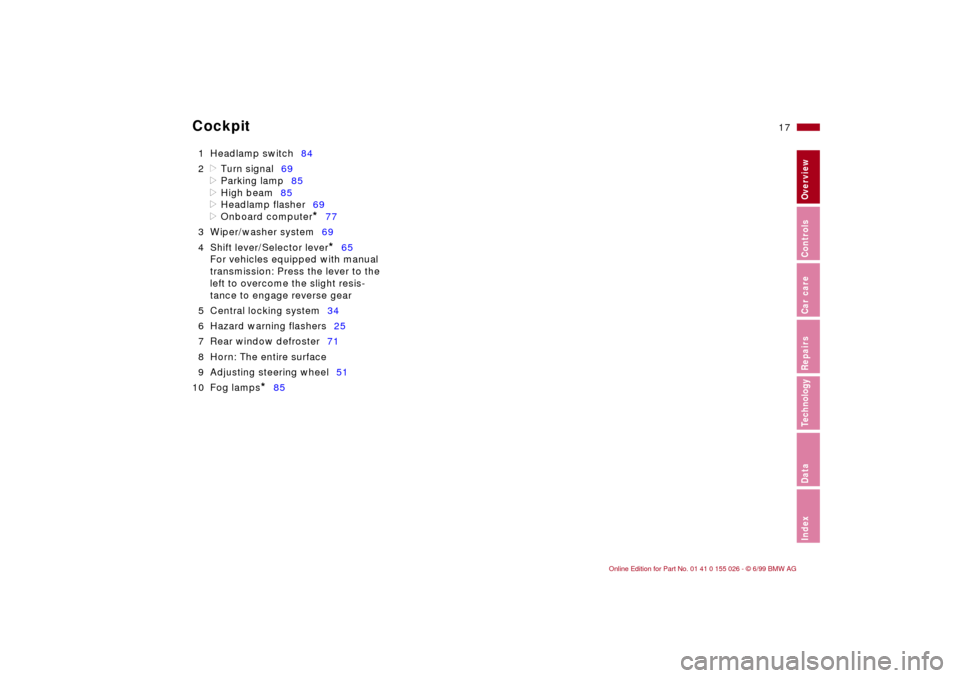
17n
RepairsIndexOverview Controls Car care Technology Data
Cockpit
1 Headlamp switch84
2
d
Turn signal69
>
Parking lamp85
>
High beam85
>
Headlamp flasher69
>
Onboard computer
*
77
3 Wiper/washer system69
4 Shift lever/Selector lever
*
65
For vehicles equipped with manual
transmission: Press the lever to the
left to overcome the slight resis-
tance to engage reverse gear
5 Central locking system34
6 Hazard warning flashers25
7 Rear window defroster71
8 Horn: The entire surface
9 Adjusting steering wheel51
10 Fog lamps
*
85
Page 21 of 189
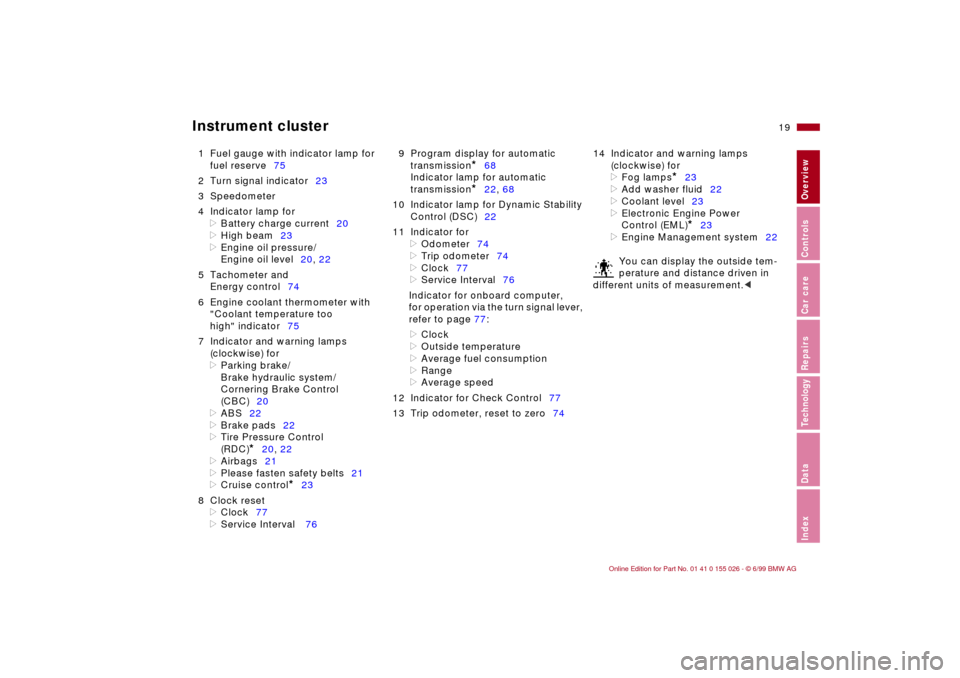
19n
RepairsIndexOverview Controls Car care Technology Data
Instrument cluster
1 Fuel gauge with indicator lamp for
fuel reserve75
2 Turn signal indicator23
3 Speedometer
4 Indicator lamp for
>
Battery charge current20
>
High beam23
>
Engine oil pressure/
Engine oil level20, 22
5 Tachometer and
Energy control74
6 Engine coolant thermometer with
"Coolant temperature too
high" indicator75
7 Indicator and warning lamps
(clockwise) for
>
Parking brake/
Brake hydraulic system/
Cornering Brake Control
(CBC)20
>
ABS22
>
Brake pads22
>
Tire Pressure Control
(RDC)
*
20, 22
>
Airbags21
>
Please fasten safety belts21
>
Cruise control
*
23
8 Clock reset
>
Clock77
>
Service Interval 769 Program display for automatic
transmission
*
68
Indicator lamp for automatic
transmission
*
22, 68
10 Indicator lamp for Dynamic Stability
Control (DSC)22
11 Indicator for
>
Odometer74
>
Trip odometer74
>
Clock77
>
Service Interval76
Indicator for onboard computer,
for operation via the turn signal lever,
refer to page 77:
>
Clock
>
Outside temperature
>
Average fuel consumption
>
Range
>
Average speed
12 Indicator for Check Control77
13 Trip odometer, reset to zero7414 Indicator and warning lamps
(clockwise) for
>
Fog lamps
*
23
>
Add washer fluid22
>
Coolant level23
>
Electronic Engine Power
Control (EML)
*
23
>
Engine Management system22
You can display the outside tem-
perature and distance driven in
different units of measurement.
<
Page 22 of 189
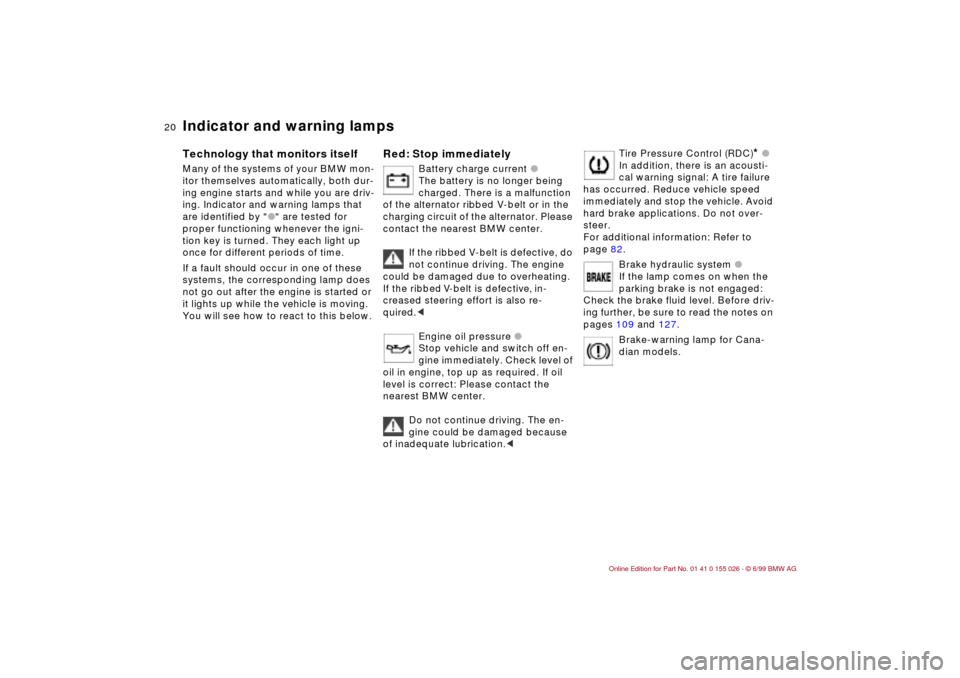
20n
Indicator and warning lamps
Technology that monitors itself
Many of the systems of your BMW mon-
itor themselves automatically, both dur-
ing engine starts and while you are driv-
ing. Indicator and warning lamps that
are identified by "
l
" are tested for
proper functioning whenever the igni-
tion key is turned. They each light up
once for different periods of time.
If a fault should occur in one of these
systems, the corresponding lamp does
not go out after the engine is started or
it lights up while the vehicle is moving.
You will see how to react to this below.
Red: Stop immediately
Battery charge current
l
The battery is no longer being
charged. There is a malfunction
of the alternator ribbed V-belt or in the
charging circuit of the alternator. Please
contact the nearest BMW center.
If the ribbed V-belt is defective, do
not continue driving. The engine
could be damaged due to overheating.
If the ribbed V-belt is defective, in-
creased steering effort is also re-
quired.
<
Engine oil pressure
l
Stop vehicle and switch off en-
gine immediately. Check level of
oil in engine, top up as required. If oil
level is correct: Please contact the
nearest BMW center.
Do not continue driving. The en-
gine could be damaged because
of inadequate lubrication.
<
Tire Pressure Control (RDC)
* l
In addition, there is an acousti-
cal warning signal: A tire failure
has occurred. Reduce vehicle speed
immediately and stop the vehicle. Avoid
hard brake applications. Do not over-
steer.
For additional information: Refer to
page 82.
Brake hydraulic system l
If the lamp comes on when the
parking brake is not engaged:
Check the brake fluid level. Before driv-
ing further, be sure to read the notes on
pages 109 and 127.
Brake-warning lamp for Cana-
dian models.
Page 25 of 189
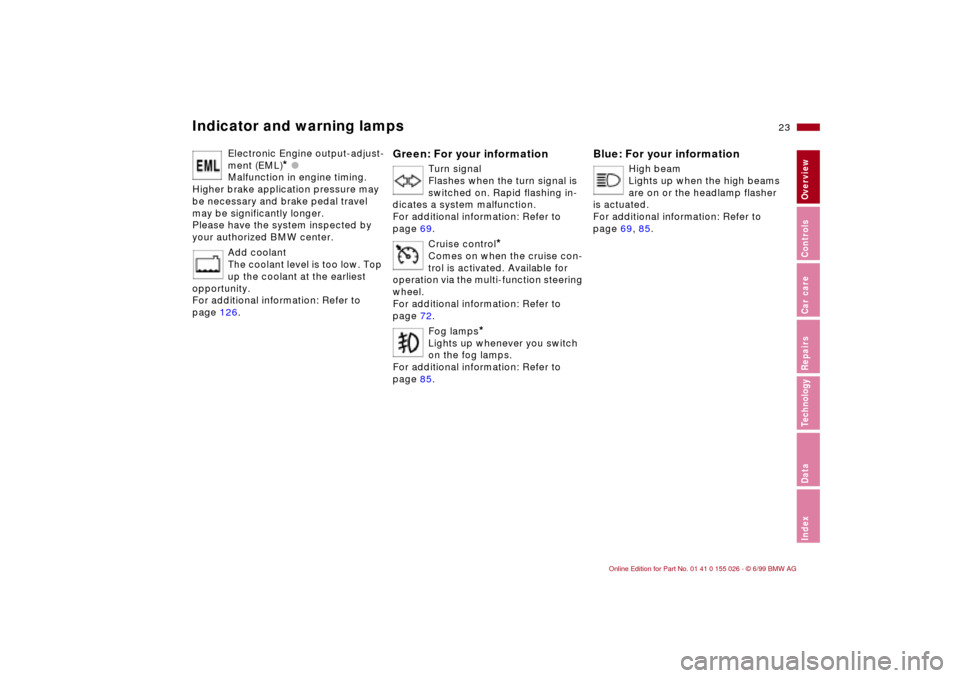
23n
RepairsIndexOverview Controls Car care Technology Data
Indicator and warning lamps
Electronic Engine output-adjust-
ment (EML)
* l
Malfunction in engine timing.
Higher brake application pressure may
be necessary and brake pedal travel
may be significantly longer.
Please have the system inspected by
your authorized BMW center.
Add coolant
The coolant level is too low. Top
up the coolant at the earliest
opportunity.
For additional information: Refer to
page 126.
Green: For your information
Turn signal
Flashes when the turn signal is
switched on. Rapid flashing in-
dicates a system malfunction.
For additional information: Refer to
page 69.
Cruise control
*
Comes on when the cruise con-
trol is activated. Available for
operation via the multi-function steering
wheel.
For additional information: Refer to
page 72.
Fog lamps
*
Lights up whenever you switch
on the fog lamps.
For additional information: Refer to
page 85.
Blue: For your information
High beam
Lights up when the high beams
are on or the headlamp flasher
is actuated.
For additional information: Refer to
page 69, 85.
Page 33 of 189

Overview
Controls and features
Operation, care
and maintenance
Owner service procedures
Technical data
Index Advanced technology
31n
RepairsIndexOverview Controls Car care Technology Data
Manual transmission65
Automatic transmission with
Steptronic66
Turn signal/Headlamp flasher69
Wiper/washer system/Rain
sensor69
Rear window defroster71
Cruise control72
Everything under control:
Odometer74
Tachometer74
Energy control74
Fuel gauge75
Temperature gauge75
Service Interval Display76
Check Control77
Clock77
Onboard computer77
Technology for safety and
convenience:
Park Distance Control (PDC)80
Dynamic Stability Control
(DSC)81
Tire Pressure Control (RDC)82Lamps:
Parking lamps/Headlamps84
Instrument panel rheostat84
High beams/Parking lamps85
Fog lamps85
Interior lamps85
Reading lamps86
Controlling the climate
for pleasant driving:
Automatic climate control88
Heated seats93
Roller sun blind93
Cabin convenience:
HiFi System94
Glove compartment94
Storage compartments95
Cellular phones95
Ashtray96
Cigarette lighter96
Clothes hooks97
Loading and transporting:
Through-loading facility98
Ski bag99
Cargo loading100
Roof-mounted luggage rack101
Page 64 of 189
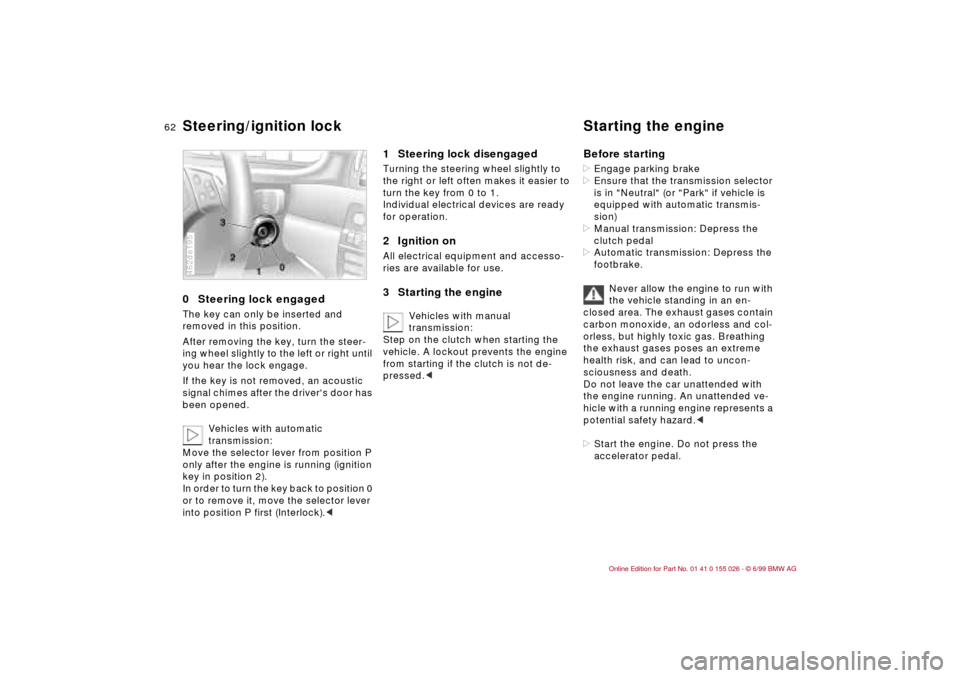
62n
0 Steering lock engaged The key can only be inserted and
removed in this position.
After removing the key, turn the steer-
ing wheel slightly to the left or right until
you hear the lock engage.
If the key is not removed, an acoustic
signal chimes after the driver's door has
been opened.
Vehicles with automatic
transmission:
Move the selector lever from position P
only after the engine is running (ignition
key in position 2).
In order to turn the key back to position 0
or to remove it, move the selector lever
into position P first (Interlock).<462de195
1 Steering lock disengaged Turning the steering wheel slightly to
the right or left often makes it easier to
turn the key from 0 to 1.
Individual electrical devices are ready
for operation.2 Ignition onAll electrical equipment and accesso-
ries are available for use.3 Starting the engine
Vehicles with manual
transmission:
Step on the clutch when starting the
vehicle. A lockout prevents the engine
from starting if the clutch is not de-
pressed.c
Before starting>Engage parking brake
>Ensure that the transmission selector
is in "Neutral" (or "Park" if vehicle is
equipped with automatic transmis-
sion)
>Manual transmission: Depress the
clutch pedal
>Automatic transmission: Depress the
footbrake.
Never allow the engine to run with
the vehicle standing in an en-
closed area. The exhaust gases contain
carbon monoxide, an odorless and col-
orless, but highly toxic gas. Breathing
the exhaust gases poses an extreme
health risk, and can lead to uncon-
sciousness and death.
Do not leave the car unattended with
the engine running. An unattended ve-
hicle with a running engine represents a
potential safety hazard.<
>Start the engine. Do not press the
accelerator pedal.
Steering/ignition lock Starting the engine
Page 71 of 189
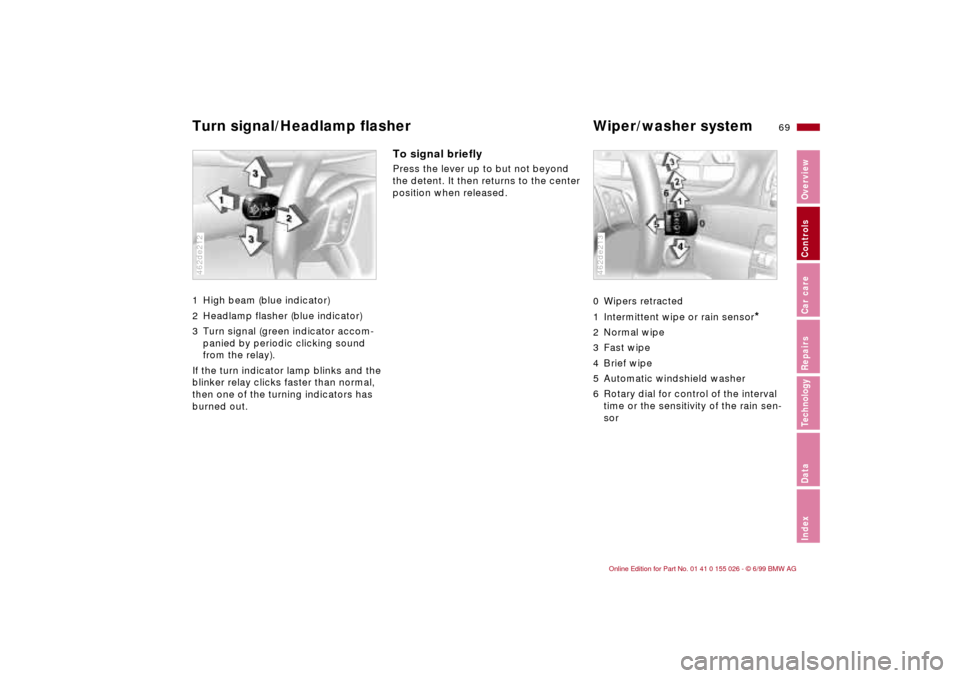
69n
RepairsIndexOverview Controls Car care Technology Data
Turn signal/Headlamp flasher Wiper/washer system 1 High beam (blue indicator)
2 Headlamp flasher (blue indicator)
3 Turn signal (green indicator accom-
panied by periodic clicking sound
from the relay).
If the turn indicator lamp blinks and the
blinker relay clicks faster than normal,
then one of the turning indicators has
burned out.462de212
To signal brieflyPress the lever up to but not beyond
the detent. It then returns to the center
position when released.
0 Wipers retracted
1 Intermittent wipe or rain sensor
*
2 Normal wipe
3 Fast wipe
4 Brief wipe
5 Automatic windshield washer
6 Rotary dial for control of the interval
time or the sensitivity of the rain sen-
sor462de213